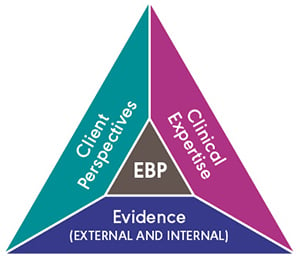
Evidence-based practice (EBP) is the integration of

When all three components of EBP are considered together, clinicians can make informed,
evidence-based decisions and provide high-quality services reflecting the interests, values, needs,
and choices of individuals with communication disorders.
Evidence-based practice (EBP) is the process of applying current, best evidence (external and internal scientific evidence), patient perspective, and clinical expertise to make decisions about the care of the individuals you treat. This page will teach you this versatile process so you can be confident that you're providing the best possible care no matter what clinical questions may arise.

Follow these steps to initiate and implement EBP into your clinical practice.
Learn more about concepts found within EBP.
A collection of PDFs to guide you as you implement the evidence-based practice (EBP)
process for your own clinical questions.
A searchable online tool designed to assist clinicians with making evidence-based decisions.
A curated collection of documents and articles to help ASHA members understand
and implement evidence-based practice (EBP).
Finding the Best Evidence Fast, Dysphagia Café
How to navigate the post-PDPM landscape with evidence-based dysphagia interventions.
How ASHA's Evidence Maps Save You Time, Eat, Speak & Think
Learn how to navigate the Evidence Maps - ASHA's online tool to find the best evidence fast.
How to Make Data Work for You as a School-Based SLP, Natalie Synders SLP
Learn how data, both internal and external, drives the vital decisions that school-based SLPs make every day.
Using Evidence-Based Practice in the Schools, Crazy Speech World
Use ASHA's DECIDE framework to integrate the three components of evidence-based practice – external and internal evidence, clinical expertise, and client perspectives – into a clinical decision.
How to Know the Evidence, Using Shortcuts Specifically Designed for Speech-Language Pathologists, The Informed SLP
Compare the features of three different platforms that help clinicians keep up on the latest evidence in our field.
Applying ASHA's Evidence Maps to My Caseload, Eat, Speak & Think
Read the five things one clinician discovered when she applied ASHA's Evidence Maps to her current caseload.
ASHA, SLP, & EBP in 2020, SLP R&R
Learn more about what the EBP toolkit has to offer.
Entries in this glossary were adapted from a number of sources, including
The definitions often differ slightly among these sources. Although we have selected a definition for each entry to get you started, your understanding of these concepts will grow if you examine the definitions provided at the websites listed above.
This glossary is a work in progress; entries will be added and updated over time and in response to feedback from users. Please send your comments and suggestions to ncep@asha.org.
Informational, interactive, and video resources to help clinicians expand their
understanding of evidence-based practice (EBP).